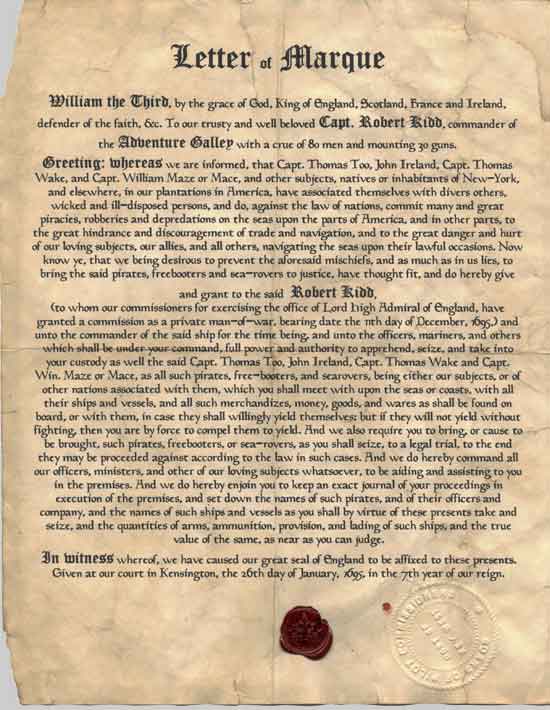Consider This: Privateers and Letters of Marque
Piracy has always been a problem, and one solution that was devised in Europe was to allow merchant ships to arm themselves and protect their cargo. Called "privateers", these ships became the legitimate owners of that ship and all its cargo under the authority of their government if they managed to capture a pirate vessel. The sailors aboard these privateering vessels were awarded a share of the loot from the ships they captured, an attractive alternative to the wages offered on naval ships. In times of war, privateers were authorized to attack and seize ships belonging to enemy nations in the same manner. As such, an English privateer could attack a Spanish cargo ship and steal its goods in the same manner as a pirate, but be immune to the punishment that a pirate would earn if caught. The most famous privateer, Sir Francis Drake, was a knighted hero in England and branded a pirate and a criminal in Spain. King Phillip II of Spain offered a reward for his capture or death that would amount to $8 million in today's currency.
Scene from Pirates of the Caribbean: Dead Man's Chest featuring letters of marque, the documentation of a privateer.
The line between pirate and privateer was blurry at the best of times. Oftentimes, the official status could be given or revoked to a captain if they fall into or out of favor with their government. For example, take the complex life of Captain William Kidd. in 1695 Kidd was granted a royal commission as a privateer for the English crown. He was issued official documentation with a letter of marque; an grant from a nation to privateer under their authority. Under orders to seize French vessels and pirates in the West Indies, he quickly encountered difficulties with illness among his crew and a lack of French prey. Kidd's crew pressured him to sail towards Madagascar, another place where pirates were abundant. There in the Indian sea, they encountered and captured an enormous Armenian cargo vessel, carrying gold, silk, spices, and other riches. However, the vessel was owned by a powerful minister of the court of the Indian Grand Moghul. The minister used his connections to complain to the East India Trading Company, a very influential trading company in England. Kidd was cast as a pirate and a criminal. He was arrested and sent back to England, where his connections in high places refused to help him. His letters of marque were hidden, and he was hanged in 1701.

Artistic rendering of Captain William Kidd's Letter of Marque
Doesn't the concept of a privateer as a "pirate for hire" created by the imperial powers solidify the idea of piracy as just another facet of colonialism in the New World?
Proceed
